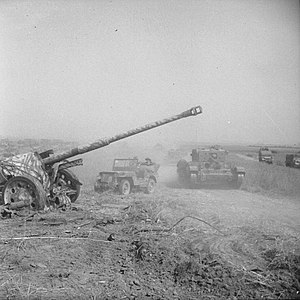Operation Totalize
| Operation Totalize | |||||||
|---|---|---|---|---|---|---|---|
| Part of Operation Overlord | |||||||
 A Cromwell tank and jeep pass an abandoned German 88mm anti-tank gun during Operation Totalize, 8 August 1944. |
|||||||
|
|||||||
| Belligerents | |||||||
|
|
|
||||||
| Commanders and leaders | |||||||
|
|
|
||||||
| Strength | |||||||
| 85,000 men 2,000 aircraft 720 artillery pieces 3 infantry divisions, 2 armoured divisions, 2 armoured brigades |
3 infantry divisions, 1 SS Panzer division, 1 heavy tank battalion At least 74 tanks |
||||||
| Casualties and losses | |||||||
| At least 1,256 146+ tanks |
3,000 casualties At least 45 tanks |
||||||
Operation Totalize (also spelled "Operation Totalise" in some more recent British sources) was an offensive launched by Allied troops of the First Canadian Army during the later stages of Operation Overlord, from 8 to 13 August 1944. The intention was to break through the German defences south of Caen on the eastern flank of the Allied positions in Normandy and exploit success by driving south to capture the high ground north of the city of Falaise. The goal was to precipitate the collapse of the entire German front, and cut off the retreat of German forces fighting American and British armies further west. The battle is considered the inaugural operation of the First Canadian Army, which had been formally activated on 23 July.
In the early hours of 8 August 1944, II Canadian Corps launched the attack using mechanized infantry. They broke through the German front lines and captured vital positions deep in the German defences. It was intended that two fresh armoured divisions would continue the attack, but some hesitancy by these two comparatively inexperienced divisions and German armoured counter-attacks slowed the offensive. Having advanced 9 mi (14 km), the Allies were halted 7 mi (11 km) north of Falaise, and forced to prepare a fresh attack.
Caen had been an objective of the British forces assaulting Sword Beach on D-Day. However, the German defences were strongest in this sector, and most of the German reinforcements sent to Normandy were committed to the defence of the city. Positional warfare ensued for the next six weeks. Several attempts by British and Canadian forces to capture Caen were unsuccessful until 9 July, when all of the city, north of the Orne River, was captured during Operation Charnwood. Between 18 July and 20 July, British forces launched Operation Goodwood to outflank the city to the east and south, while Canadian forces mounted Operation Atlantic to cross the Orne River and clear the remaining portions of the city. Although Operation Goodwood was halted with heavy tank losses, the two operations ultimately secured a bridgehead 6 mi (9.7 km) wide and 3 mi (4.8 km) deep south of the Orne.
...
Wikipedia
